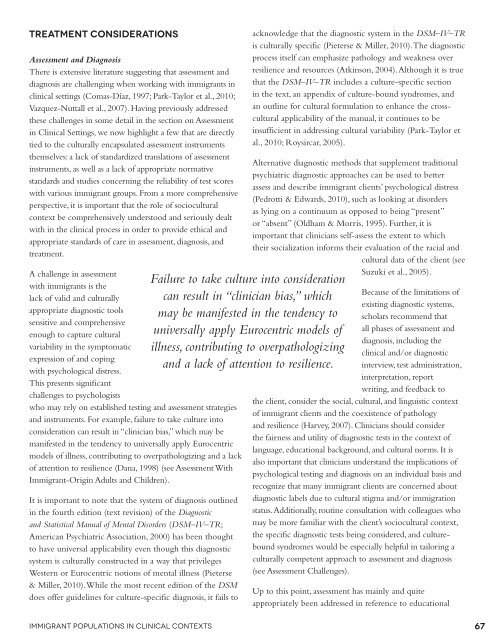Crossroads: The Psychology of Immigration in the New Century
Crossroads: The Psychology of Immigration in the New Century
Crossroads: The Psychology of Immigration in the New Century
Create successful ePaper yourself
Turn your PDF publications into a flip-book with our unique Google optimized e-Paper software.
Treatment Considerations<br />
Assessment and Diagnosis<br />
<strong>The</strong>re is extensive literature suggest<strong>in</strong>g that assessment and<br />
diagnosis are challeng<strong>in</strong>g when work<strong>in</strong>g with immigrants <strong>in</strong><br />
cl<strong>in</strong>ical sett<strong>in</strong>gs (Comas-Díaz, 1997; Park-Taylor et al., 2010;<br />
Vazquez-Nuttall et al., 2007). Hav<strong>in</strong>g previously addressed<br />
<strong>the</strong>se challenges <strong>in</strong> some detail <strong>in</strong> <strong>the</strong> section on Assessment<br />
<strong>in</strong> Cl<strong>in</strong>ical Sett<strong>in</strong>gs, we now highlight a few that are directly<br />
tied to <strong>the</strong> culturally encapsulated assessment <strong>in</strong>struments<br />
<strong>the</strong>mselves: a lack <strong>of</strong> standardized translations <strong>of</strong> assessment<br />
<strong>in</strong>struments, as well as a lack <strong>of</strong> appropriate normative<br />
standards and studies concern<strong>in</strong>g <strong>the</strong> reliability <strong>of</strong> test scores<br />
with various immigrant groups. From a more comprehensive<br />
perspective, it is important that <strong>the</strong> role <strong>of</strong> sociocultural<br />
context be comprehensively understood and seriously dealt<br />
with <strong>in</strong> <strong>the</strong> cl<strong>in</strong>ical process <strong>in</strong> order to provide ethical and<br />
appropriate standards <strong>of</strong> care <strong>in</strong> assessment, diagnosis, and<br />
treatment.<br />
A challenge <strong>in</strong> assessment<br />
with immigrants is <strong>the</strong><br />
lack <strong>of</strong> valid and culturally<br />
appropriate diagnostic tools<br />
sensitive and comprehensive<br />
enough to capture cultural<br />
variability <strong>in</strong> <strong>the</strong> symptomatic<br />
expression <strong>of</strong> and cop<strong>in</strong>g<br />
with psychological distress.<br />
This presents significant<br />
challenges to psychologists<br />
who may rely on established test<strong>in</strong>g and assessment strategies<br />
and <strong>in</strong>struments. For example, failure to take culture <strong>in</strong>to<br />
consideration can result <strong>in</strong> “cl<strong>in</strong>ician bias,” which may be<br />
manifested <strong>in</strong> <strong>the</strong> tendency to universally apply Eurocentric<br />
models <strong>of</strong> illness, contribut<strong>in</strong>g to overpathologiz<strong>in</strong>g and a lack<br />
<strong>of</strong> attention to resilience (Dana, 1998) (see Assessment With<br />
Immigrant-Orig<strong>in</strong> Adults and Children).<br />
It is important to note that <strong>the</strong> system <strong>of</strong> diagnosis outl<strong>in</strong>ed<br />
<strong>in</strong> <strong>the</strong> fourth edition (text revision) <strong>of</strong> <strong>the</strong> Diagnostic<br />
and Statistical Manual <strong>of</strong> Mental Disorders (DSM–IV–TR;<br />
American Psychiatric Association, 2000) has been thought<br />
to have universal applicability even though this diagnostic<br />
system is culturally constructed <strong>in</strong> a way that privileges<br />
Western or Eurocentric notions <strong>of</strong> mental illness (Pieterse<br />
& Miller, 2010). While <strong>the</strong> most recent edition <strong>of</strong> <strong>the</strong> DSM<br />
does <strong>of</strong>fer guidel<strong>in</strong>es for culture-specific diagnosis, it fails to<br />
Immigrant Populations <strong>in</strong> Cl<strong>in</strong>ical Contexts<br />
Failure to take culture <strong>in</strong>to consideration<br />
can result <strong>in</strong> “cl<strong>in</strong>ician bias,” which<br />
may be manifested <strong>in</strong> <strong>the</strong> tendency to<br />
universally apply Eurocentric models <strong>of</strong><br />
illness, contribut<strong>in</strong>g to overpathologiz<strong>in</strong>g<br />
and a lack <strong>of</strong> attention to resilience.<br />
acknowledge that <strong>the</strong> diagnostic system <strong>in</strong> <strong>the</strong> DSM–IV–TR<br />
is culturally specific (Pieterse & Miller, 2010). <strong>The</strong> diagnostic<br />
process itself can emphasize pathology and weakness over<br />
resilience and resources (Atk<strong>in</strong>son, 2004). Although it is true<br />
that <strong>the</strong> DSM–IV–TR <strong>in</strong>cludes a culture-specific section<br />
<strong>in</strong> <strong>the</strong> text, an appendix <strong>of</strong> culture-bound syndromes, and<br />
an outl<strong>in</strong>e for cultural formulation to enhance <strong>the</strong> crosscultural<br />
applicability <strong>of</strong> <strong>the</strong> manual, it cont<strong>in</strong>ues to be<br />
<strong>in</strong>sufficient <strong>in</strong> address<strong>in</strong>g cultural variability (Park-Taylor et<br />
al., 2010; Roysircar, 2005).<br />
Alternative diagnostic methods that supplement traditional<br />
psychiatric diagnostic approaches can be used to better<br />
assess and describe immigrant clients’ psychological distress<br />
(Pedrotti & Edwards, 2010), such as look<strong>in</strong>g at disorders<br />
as ly<strong>in</strong>g on a cont<strong>in</strong>uum as opposed to be<strong>in</strong>g “present”<br />
or “absent” (Oldham & Morris, 1995). Fur<strong>the</strong>r, it is<br />
important that cl<strong>in</strong>icians self-assess <strong>the</strong> extent to which<br />
<strong>the</strong>ir socialization <strong>in</strong>forms <strong>the</strong>ir evaluation <strong>of</strong> <strong>the</strong> racial and<br />
cultural data <strong>of</strong> <strong>the</strong> client (see<br />
Suzuki et al., 2005).<br />
Because <strong>of</strong> <strong>the</strong> limitations <strong>of</strong><br />
exist<strong>in</strong>g diagnostic systems,<br />
scholars recommend that<br />
all phases <strong>of</strong> assessment and<br />
diagnosis, <strong>in</strong>clud<strong>in</strong>g <strong>the</strong><br />
cl<strong>in</strong>ical and/or diagnostic<br />
<strong>in</strong>terview, test adm<strong>in</strong>istration,<br />
<strong>in</strong>terpretation, report<br />
writ<strong>in</strong>g, and feedback to<br />
<strong>the</strong> client, consider <strong>the</strong> social, cultural, and l<strong>in</strong>guistic context<br />
<strong>of</strong> immigrant clients and <strong>the</strong> coexistence <strong>of</strong> pathology<br />
and resilience (Harvey, 2007). Cl<strong>in</strong>icians should consider<br />
<strong>the</strong> fairness and utility <strong>of</strong> diagnostic tests <strong>in</strong> <strong>the</strong> context <strong>of</strong><br />
language, educational background, and cultural norms. It is<br />
also important that cl<strong>in</strong>icians understand <strong>the</strong> implications <strong>of</strong><br />
psychological test<strong>in</strong>g and diagnosis on an <strong>in</strong>dividual basis and<br />
recognize that many immigrant clients are concerned about<br />
diagnostic labels due to cultural stigma and/or immigration<br />
status. Additionally, rout<strong>in</strong>e consultation with colleagues who<br />
may be more familiar with <strong>the</strong> client’s sociocultural context,<br />
<strong>the</strong> specific diagnostic tests be<strong>in</strong>g considered, and culturebound<br />
syndromes would be especially helpful <strong>in</strong> tailor<strong>in</strong>g a<br />
culturally competent approach to assessment and diagnosis<br />
(see Assessment Challenges).<br />
Up to this po<strong>in</strong>t, assessment has ma<strong>in</strong>ly and quite<br />
appropriately been addressed <strong>in</strong> reference to educational<br />
67
















